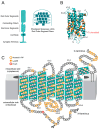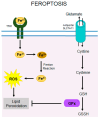Mechanisms of Rhodopsin-Related Inherited Retinal Degeneration and Pharmacological Treatment Strategies
- PMID: 39791750
- PMCID: PMC11720364
- DOI: 10.3390/cells14010049
Mechanisms of Rhodopsin-Related Inherited Retinal Degeneration and Pharmacological Treatment Strategies
Abstract
Retinitis pigmentosa (RP) is a hereditary disease characterized by progressive vision loss ultimately leading to blindness. This condition is initiated by mutations in genes expressed in retinal cells, resulting in the degeneration of rod photoreceptors, which is subsequently followed by the loss of cone photoreceptors. Mutations in various genes expressed in the retina are associated with RP. Among them, mutations in the rhodopsin gene (RHO) are the most common cause of this condition. Due to the involvement of numerous genes and multiple mutations in a single gene, RP is a highly heterogeneous disease making the development of effective treatments particularly challenging. The progression of this disease involves complex cellular responses to restore cellular homeostasis, including the unfolded protein response (UPR) signaling, autophagy, and various cell death pathways. These mechanisms, however, often fail to prevent photoreceptor cell degradation and instead contribute to cell death under certain conditions. Current research focuses on the pharmacological modulation of the components of these pathways and the direct stabilization of mutated receptors as potential treatment strategies. Despite these efforts, the intricate interplay between these mechanisms and the diverse causative mutations involved has hindered the development of effective treatments. Advancing our understanding of the interactions between photoreceptor cell death mechanisms and the specific genetic mutations driving RP is critical to accelerate the discovery and development of therapeutic strategies for this currently incurable disease.
Keywords: misfolding; neuroinflammation; oxidative stress; photoreceptor; retinal degeneration; rhodopsin.
Conflict of interest statement
The authors declare no conflicts of interest.
Figures







Similar articles
-
The heat-shock response co-inducer arimoclomol protects against retinal degeneration in rhodopsin retinitis pigmentosa.Cell Death Dis. 2014 May 22;5(5):e1236. doi: 10.1038/cddis.2014.214. Cell Death Dis. 2014. PMID: 24853414 Free PMC article.
-
Rhodopsin-mediated retinitis pigmentosa.Prog Mol Biol Transl Sci. 2009;88:1-31. doi: 10.1016/S1877-1173(09)88001-0. Epub 2009 Oct 7. Prog Mol Biol Transl Sci. 2009. PMID: 20374723 Review.
-
Rhodopsin homeostasis and retinal degeneration: lessons from the fly.Trends Neurosci. 2013 Nov;36(11):652-60. doi: 10.1016/j.tins.2013.08.003. Epub 2013 Sep 5. Trends Neurosci. 2013. PMID: 24012059 Free PMC article. Review.
-
Cell Death Pathways in Mutant Rhodopsin Rat Models Identifies Genotype-Specific Targets Controlling Retinal Degeneration.Mol Neurobiol. 2019 Mar;56(3):1637-1652. doi: 10.1007/s12035-018-1192-8. Epub 2018 Jun 18. Mol Neurobiol. 2019. PMID: 29911255
-
Flavonoids improve the stability and function of P23H rhodopsin slowing down the progression of retinitis pigmentosa in mice.J Neurosci Res. 2022 Apr;100(4):1063-1083. doi: 10.1002/jnr.25021. Epub 2022 Feb 15. J Neurosci Res. 2022. PMID: 35165923 Free PMC article.
Cited by
-
Aggregation of the Constitutively Active K296E Rhodopsin Mutant Contributes to Retinal Degeneration.FASEB J. 2025 Jul 31;39(14):e70848. doi: 10.1096/fj.202501043R. FASEB J. 2025. PMID: 40667763 Free PMC article.
-
Neuroprotection provided by polyphenols and flavonoids in photoreceptor degenerative diseases.Neural Regen Res. 2026 Mar 1;21(3):908-922. doi: 10.4103/NRR.NRR-D-24-01638. Epub 2025 May 6. Neural Regen Res. 2026. PMID: 40364630 Free PMC article.
-
Retinal Autophagy for Sustaining Retinal Integrity as a Proof of Concept for Age-Related Macular Degeneration.Int J Mol Sci. 2025 Jun 16;26(12):5773. doi: 10.3390/ijms26125773. Int J Mol Sci. 2025. PMID: 40565235 Free PMC article. Review.
References
-
- Kolb H. Simple Anatomy of the Retina. In: Kolb H., Fernandez E., Jones B., Nelson R., editors. Webvision: The Organization of the Retina and Visual System. University of Utah Health Sciences Center; Salt Lake City, UT, USA: 1995.
-
- Ramirez A.I., de Hoz R., Salobrar-Garcia E., Salazar J.J., Rojas B., Ajoy D., Lopez-Cuenca I., Rojas P., Trivino A., Ramirez J.M. The Role of Microglia in Retinal Neurodegeneration: Alzheimer’s Disease, Parkinson, and Glaucoma. Front. Aging Neurosci. 2017;9:214. doi: 10.3389/fnagi.2017.00214. - DOI - PMC - PubMed
Publication types
MeSH terms
Substances
Grants and funding
LinkOut - more resources
Full Text Sources

